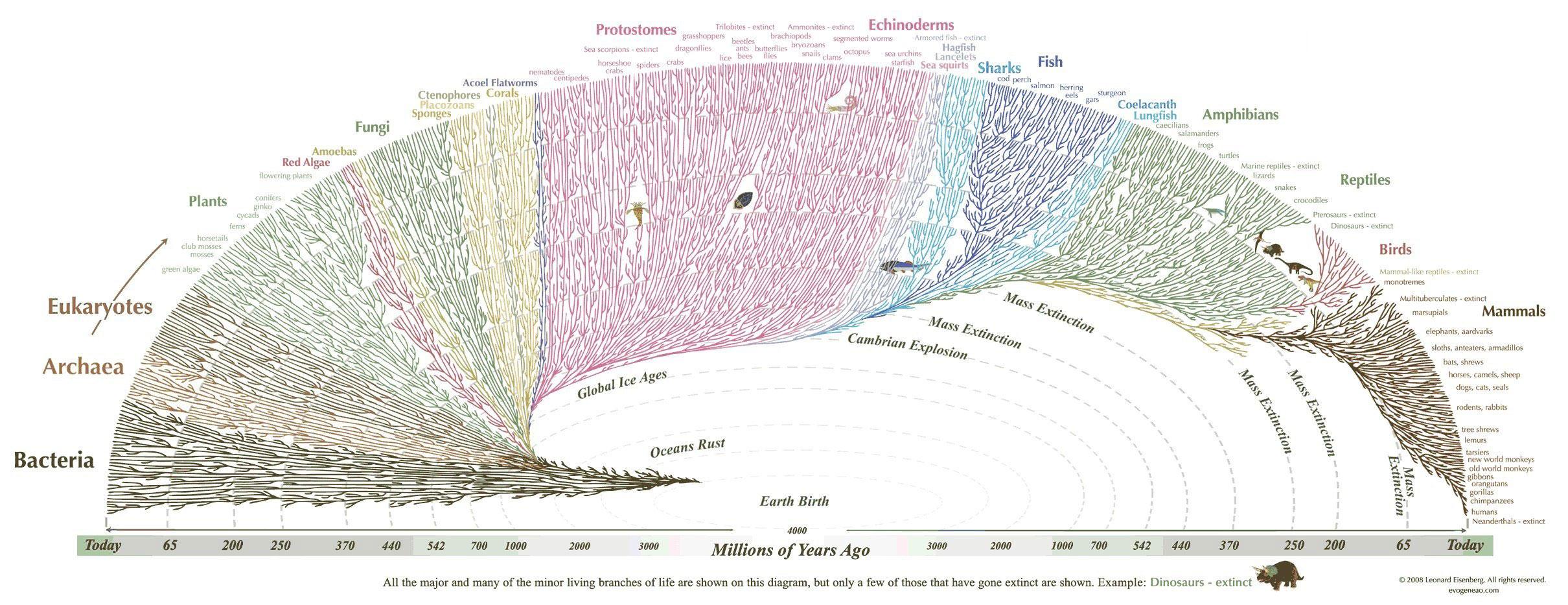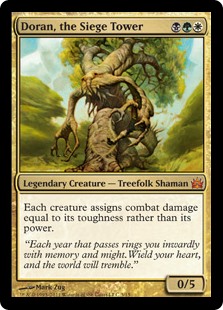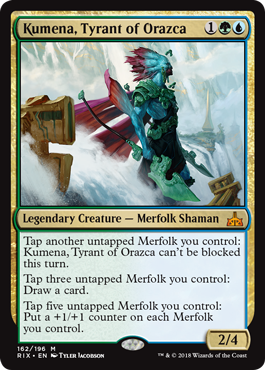Evolutionary Leap - Fungus Amongus

Establishing our Roots
Welcome, nerds, to the new article series: Evolutionary Leap! While the Scrambleverse is still my first love, and Playgroup Brews will definitely return whenever new sets come out, I really wanted to find a way to incorporate my passion and field of expertise into my articles here at EDHREC. This article is the first of hopefully many more to satisfy that need!
For those of you who do not know, I am an evolutionary biologist who specializes in marine biology. Our own Mason Brantley has, in the past, referred to me as a Magic 8 Ball of scientific knowledge, “shaking me” for random facts, which I just love giving! For most of my Magic career, I’ve been finding ways to incorporate my love for science into my love for Magic, and after a couple of years I figured out how to do so! While some people have the drive to make a deck of every color combination, or a deck representing every major archetype, or simply to just have decks of varying power levels, my drive is a little more unique. I’ve made it my mission to have a deck representing every major taxon of life here on Earth. For those who don’t know, a taxon (or clade) is a taxonomic group of any rank of life, ranging from species, to group, all the way to kingdom. I’ll give three examples to explain a bit better. I have:
- Doran, the Siege Tower as the commander for a Treefolk tribal deck, which represents Kingdom Plantae, or all plants, considering that they are the most prevalent plant-like species in MTG.
- Gishath, Sun’s Avatar as the commander for a Dinosaur tribal deck, representing Clade Dinosauria, primarily Theropod Dinosaurs (I still argue that Birds should get tribal bonuses for actually being Dinosaurs).
- Kumena, Tyrant of Orazca, representing fish in class Actinopterygii, or Ray-Finned Fishes. I have debated using Kumena to represent amphibians instead, due to the lack of frogs in Magic, and the potential to make a different Fish deck with Fish, Leviathans, etc.



I have many other decks completed and several currently in construction, but these are just some examples of the diverse taxa of life that can be created through the tribes of Magic. In each article, I'll present a commander of a tribe, followed by a discussion of my inspiration and how I evaluated that commander and chose to use it. We'll call this Urban Evolution section. Then, in Parallel Evolution, I’ll discuss the inspiration that Wizards of the Coast took from science and the natural world to create the cards within that tribe to begin with, both artistically and mechanically. After that, I'll go into the specific way I constructed the deck in Evolutionary Escalation. Finally, in Arcane Adaptation, we will get an inside look into the mind of an artist on how they approach creating artwork based on the natural world.
Without further ado, I would like to dedicate this article to my most recent addition to my arsenal of EDH decks and the most fun-guy that I know, Slimefoot the Stowaway!
Urban Evolution

Like many other janky Commander players, I was absolutely thrilled with the release of so many new legends in the world of Dominaria, and was ecstatic when I saw Slimefoot. I had debated building Thelon of Havenwood for a while at this point, but always felt weird about not having a true Fungus for the commander of a Fungus deck, and didn’t want to go down the “oops I went infinite” route with Ghave, Guru of Spores. Lo and behold, Slimefoot wasn’t just any ordinary Fungus, he was the best Fungus we could have asked for. He makes saprolings. He has interactions when things die, he is very on-theme and very flavorful for a Fungus. He hasn’t gotten that much love on EDHREC, with only 262 decks created at the time of this article, but he definitely has become a fan favorite, certainly within my playgroup and friends, and it has led to some very hilarious games already. Before taking a look at the deck, let’s take a look at where Wizards of the Coast may haven taken their inspiration from when creating the Fungus tribe.
Parallel Evolution
The Kingdom fungi are some of the craziest and most diverse organisms on the planet, with 120,000 named species and an estimated 2-4 million left undiscovered. They are split up into several sub-categories, but most of the ones you would recognize belong in one of three categories: Ascomycota (A-fungus), Basidiomycota (B-fungus), and Zygomycota (Z-fungus). Each of these are vastly different, and WOTC took direct inspiration from them in extremely variable ways. Let’s start off with Basidiomycota
Basidiomycota, meaning filamentous fungus, is where we'll see what is likely the artistic inspiration for most of our recent fungi, rather than a mechanical inspiration. These include puffballs, shelf fungi, and the very well known fungi: mushrooms. B-fungi are more on the green side of our Golgari tribe, providing fruiting bodies, using and creating nutrients for the soil, and just doing their best in nature. The filamentous portion of their name comes from how their entire bodies are made of single-cell thin, spider web-like filaments tightly wound up into a body. Cards like Sporecrown Thallid, Thallid Soothsayer, and Slimefoot himself are covered in a variety of B-fungus. Slimefoot actually appears to be made entirely of shelf fungus attached to the mycelium, or based, of a mushroom. I like to consider that the non-Thallid fungi within this deck, and even some of the Thallids, are representing this clade primarily artistically. Ascomycota though, are not very well represented artistically, and primarily are found in the mechanics of a fungus deck.




Ascomycota, meaning sac fungus, are actually very rarely in a physical, viewable form. Those that are visible include morels, truffles, and yeast. The way that A-fungus are represented in Magic seem to be primarily from the standpoint of in-game mechanics. I actually was only able to find one fungus that had a clear resemblance to Ascomycota fungi, which was Utopia Mycon, who seemed to have some blue cup fungus attached to it. There may be others I have missed or some that may potentially be interpreted as ascomycota fungi, such as Thallid Shell-Dweller, but this was the only clear representation in my opinion.


Several of our Fungus creatures use the mechanic of spore counters, such as Sporoloth Ancient, the aforementioned Utopia Mycon, and pretty much any of our older Thallids. This ability adds spore counters to your creatures on each of your upkeeps, and once they have two or three spore counters, you can remove them to create a Saproling. While the life cycles of all fungi are slightly different between these three clades, they all ultimately do have a sporing stage, where they release spores into the air that will then grow into new fungi. Having to grow into an adult stage, and take the time before releasing the spores to grow into new, juvenile fungi, represented by the Saprolings, shows how Wizards really does their homework and tries to tie in real-world science and information into their game.



Zygomycota, meaning egg fungus, are the black side of fungus. These guys are the tiny hair-like fungi you will see growing near plants, decaying matter, and dead animals, and are often mistaken for molds. They are decomposers, and can create vast networks of hyphae (fungus roots) underneath the soil and whatever they are decomposing. These, to me, are what are most similar to the Thallids.


They both grow, create spores, and then use the energy of other organisms (saprolings in this case) to grow stronger. The Thallids will use Saprolings to grant extra effects and, artistically, are also drawn with these hair-like and netting structures, as seen in Savage Thallid, Psychotrope Thallid, and Thallid Shell-Dweller. In addition, the Saproling tokens often show a variety of the characteristics of all three clades of fungi, though tend to lean more towards the network-like characteristics of Zygomycota.

Evolutionary Escalation
From an overall look of fungi, Wizards has done a great job bringing these to life within the context of the game, both artistically and mechanically. The world’s largest single organism is actually a collective of Armillaria fungus measuring 2.4 miles across when measuring their root network, which makes sense for Slimefoot considering he’s built for a token-based deck! With this commander, you can create a vast network of close-knit fungi and Saprolings. You’ll have so many on your board, there won’t be mushroom for your opponents’ creatures!
Naturally, we need to include as many of the fungi as we can, several of which I have named above, but there are only so many we can keep pumping in before the deck just doesn’t function. In order to capitalize on these abilities and have win conditions, we do need to include some non-fungus creatures. Some will produce Saprolings, like Korozda Guildmage or Nemata, Grove Guardian, while others will simply help them grow, like Thelon of Havenwood, or maybe they will simply eat them, in the case of Bloodspore Thrinax. Whether these creatures are predators, scientific mycologists devoted to the study of fungi, or simply weird hermits who want to bask in their fungi glory, they are welcome in our deck!



When Slimefoot comes to harvest his tokens for meals, it is always better if they are bountiful! The more tokens we can generate, the better. We’ve already mentioned many creatures that can produce Saprolings, so what’s the harm in adding Doubling Season, Second Harvest, and Saproling Symbiosis?Enchantments that double the tokens will help us end games.



For the rest of the deck, we are going to add what any Golgari deck would want. Our fungi can’t grow without a hefty amount of fertilizer and growing material, so we will have lots of land ramp, and lands that help Cultivate our creatures. Since fungi are known for decay and death, we will also add a host of removal spells, including Abrupt Decay, Putrefy, and Krosan Grip. Finally, we will add some card draw, some enchantment support, some recursion, and some ways to capitalize on death triggers and sacrifice, such as Ashnod’s Altar and Dictate of Erebos. When all is said and done, we get a pretty interesting deck to fiddle around with, check it out below!



[Commander]
*1 Slimefoot, the Stowaway
[/Commander]
[Creatures]
*1 Blood Artist
*1 Bloodspore Thrinax
*1 Deathspore Thallid
*1 Elvish Farmer
*1 Eternal Witness
*1 Korozda Guildmage
*1 Mazirek, Kraul Death Priest
*1 Mold Shambler
*1 Mycoloth
*1 Nemata, Grove Guardian
*1 Psychotrope Thallid
*1 Savage Thallid
*1 Spore Flower
*1 Sporecrown Thallid
*1 Sporemound
*1 Sporesower Thallid
*1 Sporoloth Ancient
*1 Tendershoot Dryad
*1 Thallid Germinator
*1 Thallid Shell-Dweller
*1 Thallid Soothsayer
*1 Thelon of Havenwood
*1 Thelonite Hermit
*1 Thorn Thallid
*1 Utopia Mycon
*1 Verdant Force
*1 Verdeloth the Ancient
*1 Viscera Seer
*1 Vitaspore Thallid
*1 Zulaport Cutthroat
[/Creatures]
[Enchantments]
*1 Cryptolith Rite
*1 Deathreap Ritual
*1 Dictate of Erebos
*1 Doubling Season
*1 Growing Rites of Itlimoc
*1 Life and Limb
*1 Necrogenesis
*1 Parallel Lives
*1 Path of Discovery
*1 Snake Umbra
*1 Sylvan Library
[/Enchantments]
[Artifacts]
*1 Ashnod's Altar
*1 Contagion Clasp
*1 Lifecrafter's Bestiary
*1 Skullclamp
*1 Sol Ring
[/Artifacts]
[Instants]
*1 Abrupt Decay
*1 Beast Within
*1 Golgari Charm
*1 Heroic Intervention
*1 Krosan Grip
*1 Putrefy
*1 Second Harvest
*1 Sprout Swarm
[/Instants]
[Sorceries]
*1 Black Sun's Zenith
*1 Cultivate
*1 Decree of Pain
*1 Harvest Season
*1 Hour of Promise
*1 Kodama's Reach
*1 Saproling Symbiosis
*1 Shamanic Revelation
*1 Skyshroud Claim
[/Sorceries]
[Lands]
*1 Blooming Marsh
*1 Bojuka Bog
*1 Cabal Coffers
*1 Command Tower
*14 Forest
*1 Grim Backwoods
*1 High Market
*1 Hissing Quagmire
*1 Llanowar Wastes
*1 Oran-Rief, the Vastwood
*7 Swamp
*1 Tainted Wood
*1 Temple of Malady
*1 Twilight Mire
*1 Urborg, Tomb of Yawgmoth
*1 Westvale Abbey
*1 Woodland Cemetery
[/Lands]
[/Deck]
Arcane Adaptation
Arcane Adaptation, the final portion of Evolutionary Leap, is going to feature the perspective of an artist who has actually gained inspiration from the natural world, adapting it into their artwork. In this case, I loved the fungus deck so much that I commissioned an alter of Slimefoot to be done for my birthday, completed by my personal favorite alterist, Will of RockyAlters. He did not disappoint and delivered an amazing piece of art. I asked him where he got his inspiration for this alter from, and what led him into the creative directions he took.

"Before beginning a project, I pull various elements from different photos I've taken or found on the internet that catch my eye. For coloration, fungi tend to be either inconspicuous and bland looking, or vibrant and colorful. Fungi also can be bioluminescent as well, all of which allowed me further creative freedom with how to show off the foiling as color. I used a lot of black lines, both shorter and longer, to showcase how fungi tend to be fibrous and stringy. Slimefoot's name gives a feeling of ichor, and since the mechanics of the card deal with death and life in gameplay itself, I wanted that swamp-like feeling to play into the alter. The small mushroom Saprolings at the bottom are a tie-in with the mechanics of the card itself, and I wanted them to have a similar feel to Slimefoot, in the presentation of red-capped mushrooms with white tendril limbs."
Rocky has definitely done some amazing work taking inspiration from the natural world while combining it with some abstraction and cool designs, and has been my favorite alterist for a long time. I look forward to having him alter more of my commanders for these decks! You can find him on Facebook at his page here for more information and to see his other alters.
The Cleanup Step

That concludes the first edition of Evolutionary Leap! Here you can see the beginnings of our MTG Tree of Life with the decks I've mentioned so far! Don't worry, we will definitely cover them all in future articles! Looking back on this deck, it’s definitely not the strongest build for Slimefoot; in the spirit of making things tribal and fun, I added cards that are suboptimal, but added more flavor (such as the simple Thallid). I’ve seen much more highly tuned decks than this one, and in my playtesting, it either wildly succeeds or does nothing for a lot of turns. That's okay, though, because I've been looking for a deck on the lower end of the power scale that I can play against new players, and I think that this build is perfect for that role. Works most of the time, wins some of the time, fun all of the time.
Fungus are within their own Kingdom, and are separate from animals and plants, and are going to be our first addition of our Magic: The Gathering Tree of Life. What did you think of this article? Are there parts you enjoyed more than others? What would you like to see me talk about in the next article? Can you think of other flavorful ways to spice up this fungus deck? Let me know in the comments!
EDHREC Code of Conduct